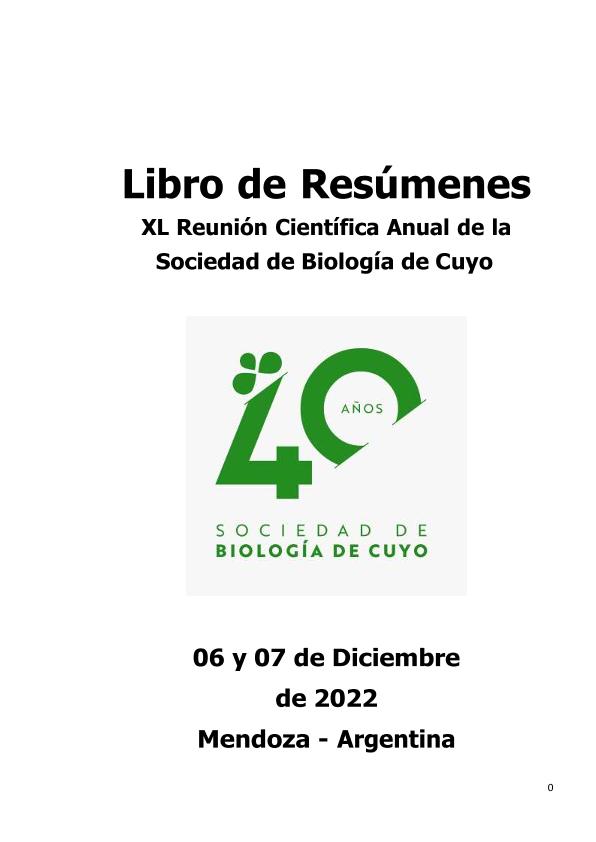Mostrar el registro sencillo del ítem
dc.contributor.author
González, Samanta Katherina

dc.contributor.author
Maldonado, Lourdes María
dc.contributor.author
Benimeli, Claudia Susana

dc.contributor.author
Polti, Marta Alejandra

dc.contributor.author
Sáez, Juliana María

dc.date.available
2023-09-04T15:41:43Z
dc.date.issued
2022
dc.identifier.citation
Bioaugmentation of biomixtures with actinobacteria for atrazine removal: optimization of inoculum concentration; XL Reunión Anual de la Sociedad de Biología de Cuyo; Mendoza; Argentina; 2022; 87-87
dc.identifier.uri
http://hdl.handle.net/11336/210387
dc.description.abstract
Biopurification systems (BPS) or biobeds are bioprophylaxis systems to prevent pesticide point-source contamination, whose efficiency relies mainly on the pesticide removal capacity of the biomixture, the majority component of a BPS. The microbial metabolic abilities of the biomixture could be improved through bioaugmentation with microorganisms with specific degrading capacities, like actinobacteria. In this sense, Streptomyces sp. M7 is a previously selected actinobacterium with well-known pesticide-degrading abilities.The aim of this work was to optimize the concentration of Streptomyces sp. M7 (M7) inoculated in organic biomixtures for atrazine (ATZ) removal. For this purpose, the biomixtures B1 and B2 were formulated with soil, peat, and sugarcane bagasse and filter cake, respectively, inoculated with three concentrations of M7 (2, 4, and 8 g kg-1), and contaminated with atrazine (50 mg kg-1). The residual concentration of ATZ and different microbial groups were determined along a 28 d-assay.In general terms, at the end of the assay, an increasing trend was shown in the microbial developments of the different groups studied in both contaminated and bioaugmented biomixtures for the three concentrations of inoculum used. In B1, the microbial counts were significantly higher with 8 g kg-1 inoculum, with respect to lower inoculum concentrations: total heterotrophic microorganisms, total bacteria, fungi, and actinobacteria reached counts of 3.2 x 107; 2.7 x 107; 1.7 x 105, and 1.5 x 107 CFU g-1, respectively. In B2, total heterotrophs, total bacteria, and actinobacteria were significantly higher for the 4 g kg-1 inoculum concentration, reaching 7.9 x 107; 1.1 x 108, and 5.9 x 107 CFU g-1, respectively; fungal counts did not show significant differences. ATZ removal showed no significant differences in B1 and B2 between the three concentrations of M7 inoculum evaluated. The concentration of 2 g kg-1 of M7 was selected for further studies considering lower costs and optimum removal efficiency.
dc.format
application/pdf
dc.language.iso
eng
dc.publisher
Sociedad de Biología de Cuyo
dc.rights
info:eu-repo/semantics/openAccess
dc.rights.uri
https://creativecommons.org/licenses/by-nc-sa/2.5/ar/
dc.subject
Bioaugmentation
dc.subject
Biomixture
dc.subject
Actinobacteria
dc.subject
Atrazine
dc.subject.classification
Biotecnología Medioambiental

dc.subject.classification
Biotecnología del Medio Ambiente

dc.subject.classification
INGENIERÍAS Y TECNOLOGÍAS

dc.title
Bioaugmentation of biomixtures with actinobacteria for atrazine removal: optimization of inoculum concentration
dc.type
info:eu-repo/semantics/publishedVersion
dc.type
info:eu-repo/semantics/conferenceObject
dc.type
info:ar-repo/semantics/documento de conferencia
dc.date.updated
2023-08-14T11:05:51Z
dc.journal.pagination
87-87
dc.journal.pais
Argentina

dc.journal.ciudad
Mendoza
dc.description.fil
Fil: González, Samanta Katherina. Consejo Nacional de Investigaciones Científicas y Técnicas. Centro Científico Tecnológico Conicet - Tucumán. Planta Piloto de Procesos Industriales Microbiológicos; Argentina
dc.description.fil
Fil: Maldonado, Lourdes María. Consejo Nacional de Investigaciones Científicas y Técnicas. Centro Científico Tecnológico Conicet - Tucumán. Planta Piloto de Procesos Industriales Microbiológicos; Argentina
dc.description.fil
Fil: Benimeli, Claudia Susana. Consejo Nacional de Investigaciones Científicas y Técnicas. Centro Científico Tecnológico Conicet - Tucumán. Planta Piloto de Procesos Industriales Microbiológicos; Argentina. Universidad Nacional de Catamarca; Argentina
dc.description.fil
Fil: Polti, Marta Alejandra. Consejo Nacional de Investigaciones Científicas y Técnicas. Centro Científico Tecnológico Conicet - Tucumán. Planta Piloto de Procesos Industriales Microbiológicos; Argentina. Universidad Nacional de Tucumán. Facultad de Ciencias Naturales e Instituto Miguel Lillo; Argentina
dc.description.fil
Fil: Sáez, Juliana María. Consejo Nacional de Investigaciones Científicas y Técnicas. Centro Científico Tecnológico Conicet - Tucumán. Planta Piloto de Procesos Industriales Microbiológicos; Argentina. Universidad Nacional de Tucumán. Facultad de Ciencias Naturales e Instituto Miguel Lillo; Argentina
dc.relation.alternativeid
info:eu-repo/semantics/altIdentifier/url/https://sbcuyo.org.ar/reuniones-anuales-anteriores/
dc.conicet.rol
Autor

dc.conicet.rol
Autor

dc.conicet.rol
Autor

dc.conicet.rol
Autor

dc.conicet.rol
Autor

dc.coverage
Nacional
dc.type.subtype
Reunión
dc.description.nombreEvento
XL Reunión Anual de la Sociedad de Biología de Cuyo
dc.date.evento
2022-12-06
dc.description.ciudadEvento
Mendoza
dc.description.paisEvento
Argentina

dc.type.publicacion
Book
dc.description.institucionOrganizadora
Sociedad de Biología de Cuyo
dc.source.libro
Libro de resúmenes de la XL Reunión Científica Anual de la Sociedad de Biología de Cuyo
dc.date.eventoHasta
2022-12-07
dc.type
Reunión
Archivos asociados
